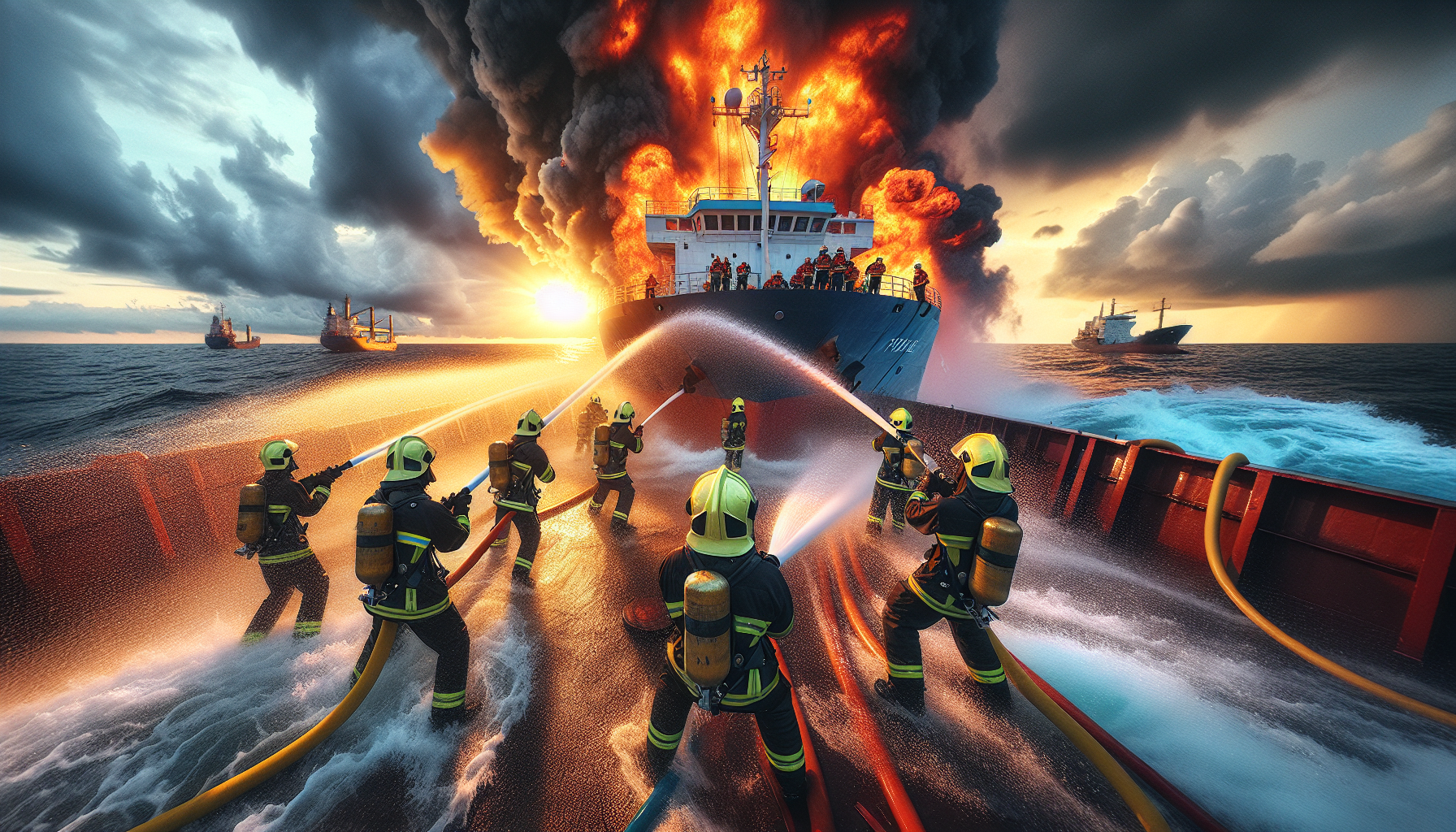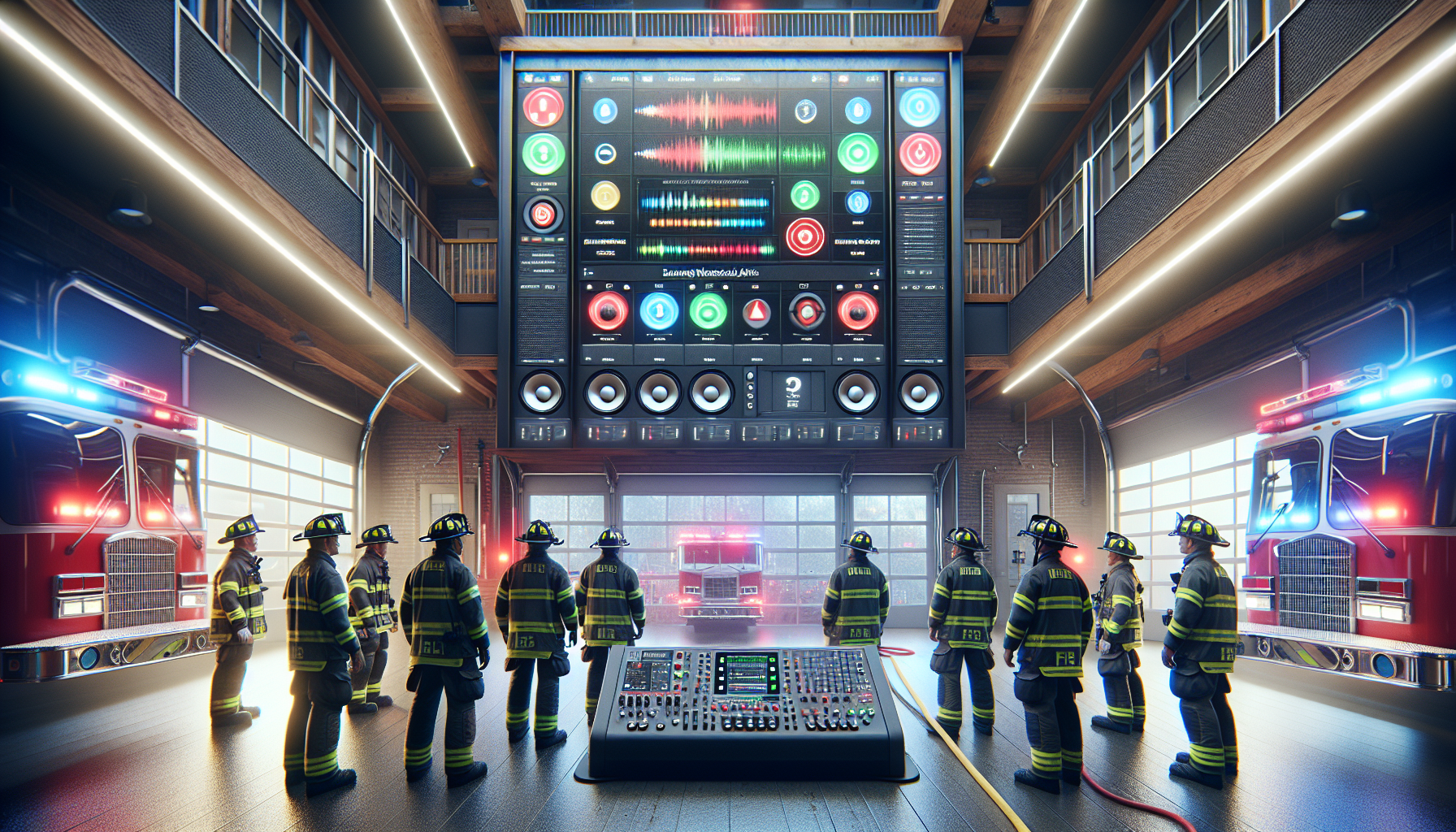In the vast, undulating expanses of the ocean, where the horizon blends seamlessly with the sky, a unique breed of heroes stands vigilant, ready to face peril at a moment’s notice. These are not your typical firefighters; they are the guardians of the sea, the protectors of lives and vessels that traverse the globe’s most unpredictable and often unforgiving waters. 🛳️🔥 Welcome to the world of shipboard firefighters, where the stakes are as high as the towering waves and the responsibilities as immense as the oceans they safeguard.
In this exploration of courage and dedication, we delve into the vital role these maritime firefighters play in ensuring safety aboard ships of all kinds. From massive cruise liners teeming with thousands of passengers to colossal cargo ships carrying invaluable goods across continents, the potential for disaster looms large. Fires at sea present a unique set of challenges, where escape routes are limited, and the nearest help might be hundreds of miles away. It is here, amidst the confined quarters and metal labyrinths of a ship, that the skill and bravery of shipboard firefighters become not just important but indispensable.
The responsibilities of these maritime guardians extend beyond merely extinguishing fires. They are integral to maintaining the ship’s safety protocols, conducting regular drills, and ensuring that every crew member is prepared for emergencies. As we navigate through this article, we will uncover the rigorous training these firefighters undergo, equipping them with the skills to combat fires in the unique environment of the high seas. From understanding the ship’s architecture to mastering firefighting techniques in confined spaces, their preparation is as exhaustive as it is essential.
Moreover, we’ll explore the technological advancements that aid these brave souls in their mission. Modern ships are equipped with sophisticated fire detection and suppression systems, and understanding these technologies is crucial for any shipboard firefighter. We’ll examine how these tools are used in tandem with human expertise to form a formidable defense against the ever-present threat of fire. In an age where technology continues to evolve, the balance between human intuition and mechanical precision becomes a key theme in ensuring maritime safety.
Lastly, we will touch upon the personal stories of those who have chosen this demanding profession. What drives someone to face such peril day after day? Through interviews and firsthand accounts, we’ll gain insight into the lives of these unsung heroes, their motivations, and the camaraderie that forms in the face of shared danger. These narratives not only highlight the personal sacrifices made but also celebrate the triumphs and resilience of those who choose to protect and serve on the high seas. 🌊
Join us as we set sail into the world of shipboard firefighters, where every day is a battle against the elements, and every victory is a testament to human courage and ingenuity. Whether you’re a maritime enthusiast or simply curious about this fascinating intersection of firefighting and seafaring, this article promises to be an enlightening journey into the heart of maritime safety.
The Unseen Heroes: Firefighters on Ships
Firefighters are universally recognized as brave individuals who run towards danger when others flee from it. However, the role of firefighters on ships, often out of sight and mind for many, is equally heroic and vitally important. The environment on a ship presents unique challenges that differentiate it from land-based firefighting, requiring specialized skills, training, and equipment. These maritime firefighters operate in confined spaces, where quick thinking and action are crucial to prevent catastrophes. In this article, we will delve deep into the crucial role these guardians of the sea play, the challenges they face, and the rigorous training they undergo to ensure the safety of everyone on board. 🚒
The life of a firefighter on a ship is anything but ordinary. While traditional firefighters deal with blazes in buildings and urban environments, their seafaring counterparts must combat fires in metal corridors, where the heat can be more intense due to the confined spaces. The risk of fire on ships is exacerbated by the presence of flammable cargo, fuels, and other materials that can easily ignite. Furthermore, in the middle of the ocean, there is no immediate backup available, and the crew must rely entirely on the onboard firefighting team to tackle any blaze effectively.
One of the unique aspects of shipboard firefighting is the use of advanced technology and equipment tailored for maritime environments. Fire suppression systems, such as water mist systems and inert gas systems, are more common on ships than on land. These systems are designed to deal with the specific challenges posed by ship fires, such as limited access to open water and the need for rapid suppression to prevent the fire from spreading to vital areas of the vessel. Additionally, firefighters are trained to use specialized gear, including thermal imaging cameras, which help them see through smoke-filled corridors and identify hot spots that need attention. These tools are indispensable in the challenging conditions they face at sea.
Training and Skills: Preparing for the Worst
Firefighters on ships undergo rigorous training that prepares them for the unique challenges of maritime firefighting. This training includes everything from basic firefighting techniques to advanced strategies for dealing with complex shipboard fires. The training is designed to ensure that all crew members are proficient in their roles during an emergency, working together seamlessly to combat the fire and ensure the safety of everyone on board.
A key component of this training is understanding the different types of fires that can occur on ships. These include electrical fires, engine room fires, and fires involving hazardous materials. Each type of fire requires a different approach, and firefighters must be adept at recognizing and responding to these various situations. They are also trained in the use of breathing apparatus, essential for operating in smoke-filled environments, and in the use of firefighting equipment specific to ships, such as fire hoses and extinguishers designed for maritime use.
In addition to firefighting skills, shipboard firefighters must be adept in other areas as well. This includes first aid and rescue techniques, as they are often the first responders in case of any onboard emergency. Their role is not limited to extinguishing fires but extends to ensuring the overall safety of the vessel and its passengers. This requires a comprehensive understanding of the ship’s layout, emergency exits, and the location of firefighting equipment. Furthermore, they must maintain physical fitness to handle the demanding nature of their work, often participating in regular drills to keep their skills sharp and ready for action.
The Technological Edge: Firefighting Equipment on Ships
In the face of maritime fires, technology plays a crucial role in augmenting the capabilities of firefighters. Ships are equipped with a variety of advanced firefighting systems that help in controlling and extinguishing fires swiftly. These systems include automatic sprinkler systems, foam fire suppression systems, and fixed fire extinguishing installations. Each of these technologies serves a specific purpose and is strategically placed throughout the ship to ensure maximum coverage and effectiveness.
One notable piece of technology is the fire detection and alarm system. These systems are designed to detect a fire at its earliest stage, allowing for a swift response. They utilize a combination of smoke detectors, heat detectors, and manual call points to alert the crew of a potential fire hazard. Once a fire is detected, an alarm is triggered, and the firefighting team is mobilized to respond. This early warning system is crucial in preventing small fires from escalating into major incidents.
To gain a better understanding of the technology used in maritime firefighting, watch the video below which provides a comprehensive overview of these systems:
Firefighting Systems on Ships – Maritime Safety Channel.
Another critical technology is the use of thermal imaging cameras. These devices allow firefighters to see through smoke and darkness, identifying hot spots and the seat of the fire. This capability is essential in the confined spaces of a ship, where visibility can be severely limited during a fire. Thermal imaging not only aids in firefighting efforts but also in search and rescue operations, helping to locate individuals who may be trapped or incapacitated.
Comparative Table of Firefighting Systems on Ships
| System Type | Function | Advantages |
|---|---|---|
| Sprinkler Systems | Automatically releases water to suppress fires. | Effective for general fire suppression and containment. |
| Foam Systems | Uses foam to smother fires, cutting off oxygen supply. | Ideal for fires involving flammable liquids. |
| Gas Systems | Releases inert gas to reduce oxygen levels and suppress fire. | Non-damaging to equipment and effective in enclosed spaces. |
Check out the table above for a detailed comparison of the firefighting systems used on ships.
Challenges and Solutions in Maritime Firefighting
Maritime firefighting presents unique challenges not typically encountered in land-based firefighting. The confined spaces and metal structures of a ship create a challenging environment where fires can spread quickly and become difficult to control. Moreover, the isolation of being at sea means there is limited access to external firefighting support, making the onboard firefighting team the sole line of defense against fires.
One of the primary challenges is dealing with the rapid spread of fire. Ships are designed with multiple compartments to prevent the spread of water, but these same compartments can also trap heat and smoke, allowing fires to grow rapidly if not addressed promptly. This requires a coordinated and swift response from the firefighting team, who must navigate through narrow corridors and staircases to reach the fire’s location.
Another challenge is the presence of hazardous materials and flammable cargo on ships. These materials can exacerbate a fire, making it more dangerous and difficult to extinguish. Firefighters must be knowledgeable about the types of materials present on the ship and the best methods for safely extinguishing them without causing further harm. This requires specialized training and equipment to handle chemical fires, fuel leaks, and other hazardous situations.
Strategies for Effective Maritime Firefighting
- Regular drills and training to maintain readiness and effectiveness in emergency situations.
- Installation and maintenance of advanced firefighting systems to provide rapid response to fires.
- Comprehensive understanding of the ship’s layout and emergency exits to facilitate quick evacuations.
- Continuous monitoring and inspection of firefighting equipment to ensure functionality when needed.
- Coordination with the ship’s crew to manage evacuations and provide assistance to passengers.
Firefighters on ships are an indispensable part of maritime safety, providing critical services in times of emergency. Their ability to adapt to challenging conditions and respond effectively to fires ensures the safety of all those on board. The combination of advanced technology, rigorous training, and strategic planning forms the backbone of successful maritime firefighting operations.

Conclusion: Guardians of the Sea: The Vital Role of Firefighters on Ships
As we navigate through the vast and unpredictable waters, the critical role of firefighters aboard ships becomes strikingly evident. These guardians of the sea stand as the frontline defense against the perils of fire, which can pose significant threats not only to the vessel but also to the safety of all those aboard and the environment. Throughout this article, we’ve delved into the multifaceted responsibilities of shipboard firefighters, the unique challenges they face, and the essential skills they must possess to effectively combat maritime fires.
First and foremost, we explored the unique environment in which shipboard firefighters operate. Unlike their counterparts on land, maritime firefighters must contend with the confined and complex layouts of ships. These spaces require specialized knowledge and adaptability, as the risk of fire spreading rapidly is significantly heightened in such enclosed areas. The volatility of fuel and other hazardous materials typically present on vessels further exacerbates these risks, necessitating a deep understanding of fire behavior and suppression techniques tailored to the maritime context.
Moreover, we examined the rigorous training and preparation that these professionals undergo. Firefighters on ships must be proficient not only in standard firefighting techniques but also in maritime safety protocols, emergency medical care, and sometimes even rescue operations. Their training is comprehensive, designed to equip them with the skills needed to tackle fires effectively and safely, thereby minimizing potential damage and loss of life. The importance of ongoing training and drills cannot be overstated, as they ensure that firefighters remain adept at responding to emergencies swiftly and efficiently.
Another significant point highlighted was the technological advancements aiding shipboard firefighters. From sophisticated fire detection and suppression systems to personal protective equipment, technology plays a crucial role in enhancing the safety and effectiveness of firefighting efforts at sea. These advancements not only improve response times but also provide firefighters with the tools needed to manage fires more effectively, ultimately safeguarding lives and minimizing environmental impact.
In emphasizing the importance of international regulations and standards, we underscored how these guidelines help maintain safety and preparedness across the maritime industry. Organizations such as the International Maritime Organization (IMO) set forth regulations that ensure ships are equipped with the necessary firefighting equipment and that crews are adequately trained. Compliance with these standards is not merely a legal obligation but a moral one, underscoring the collective responsibility to protect life and preserve the marine environment.
Furthermore, we touched upon the collaborative nature of firefighting efforts at sea. Shipboard firefighters often work in conjunction with local port authorities, coast guards, and international agencies, highlighting the importance of teamwork and communication in emergency situations. This collaboration extends beyond firefighting, encompassing rescue operations and environmental protection efforts, all of which are crucial in the maritime context.
The role of shipboard firefighters is not only vital for safety but also serves as an inspiring testament to human resilience and dedication. Their commitment to safeguarding lives and the environment reflects the broader human spirit of courage and solidarity. As we conclude, it is imperative to recognize and appreciate the vital work these brave individuals perform daily, often under challenging and dangerous conditions.
We encourage readers to reflect on the invaluable service provided by these guardians of the sea. Whether you’re involved in the maritime industry, a frequent traveler, or simply someone interested in safety and emergency preparedness, understanding the pivotal role of shipboard firefighters is crucial. We urge you to share this knowledge with others, engage in conversations about maritime safety, and advocate for continued support and investment in the resources and training these professionals need.
Let us champion the cause of maritime safety, ensuring that our guardians of the sea are equipped to protect and preserve our global waters for generations to come. Your engagement and awareness can make a significant difference, fostering a culture of safety and preparedness that extends beyond the maritime community.
🌊🚒 For further information and resources on maritime firefighting and safety standards, consider exploring the International Maritime Organization’s official website at IMO.org, where you can find a wealth of knowledge on regulations and guidelines designed to enhance safety at sea.
Thank you for joining us on this journey to explore the vital role of firefighters on ships. Let’s continue to support and honor their invaluable contribution to our safety and well-being on the seas.
Toni Santos is a visual historian and creative artisan whose work channels the bold spirit of the steam-powered era—a time when imagination, mechanics, and ambition converged to reshape the modern world. Through richly detailed visual narratives and handcrafted design, Toni celebrates the legacy of steam innovation as both an artistic and technological revolution.
Driven by a passion for mechanical aesthetics, forgotten inventions, and industrial-age ingenuity, Toni reimagines the world of steam through illustrations, tactile artifacts, and storytelling that capture the poetry of pressure, motion, and invention. From piston-driven engines to brass-detailed diagrams, each piece reveals how steam wasn’t just power—it was promise.
With a background in visual design and historical research, Toni brings a craftsman’s eye and a dreamer’s heart to the stories of tinkerers, inventors, and visionaries who shaped the 19th century. His work doesn’t merely document machines—it honors the culture, courage, and creativity that drove a world to reimagine itself through gears, valves, and vapor.
As the creative voice behind Vizovex, Toni shares curated articles, reconstructed blueprints, and visual interpretations that bring this industrial past to life. His collections serve as a tribute to:
The elegance of steam-era design and innovation
The human stories behind great mechanical feats
The aesthetic beauty found in function and form
The echo of invention in today’s creative world
Whether you’re a history lover, a fan of steampunk, or an admirer of antique technology, Toni welcomes you into a world where art and machinery fuse, one cog, one drawing, one rediscovered marvel at a time.





